Download a PDF version of this document

International Birdstrike Committee
Recommended Practices No. 1 Standards For Aerodrome
Bird/Wildlife Control
Issue 1 – October 2006
CONTENTS
-
Collaboration and Coordination between organisations on the Airport
-
Bird/Wildlife Management off the Airfield
Summary Of IBSC Standards For Aerodrome Bird/Wildlife Control
These best practice standards should apply to any aerodrome carrying regularly scheduled commercial air traffic, irrespective of the movement frequency or type of aircraft involved.
Standard 1
A named member of the senior management team at the airport should be responsible for the implementation of the bird control programme, including both habitat management and active bird control.
Standard 2
An airport should undertake a review of the features on its property that attract hazardous birds/wildlife. The precise nature of the resource that the they are attracted to should be identified and a management plan developed to eliminate or reduce the quantity of that resource, or to deny birds access to it as far as is practicable.
Where necessary, support from a professional bird/wildlife strike prevention specialist should be sought.
Documentary evidence of this process, its implementation and outcomes should be kept.
Standard 3
A properly trained and equipped bird/wildlife controller should be present on the airfield for at least 15 minutes prior to any aircraft departure or arrival. Thus, if aircraft are landing or taking of at intervals of less than 15 minutes there should be a continuous presence on the airfield throughout daylight hours. The controller should not be required to undertake any duties other than bird control during this time. Note that for aerodromes with infrequent aircraft movements, 15 minutes may not be long enough to disperse all hazardous birds/wildlife from the vicinity of the runway. In this case the controller should be deployed sufficiently in advance of the aircraft movement to allow full dispersal to be achieved.
At night, active runways and taxiways should be checked for the presence of birds/wildlife at regular intervals and the dispersal action taken as needed.
Standard 4
Bird control staff should be equipped with bird deterrent devices appropriate to the bird species encountered, the numbers of birds present, and to the area that they need to control. Staff should have access to appropriate devices for removal of birds/wildlife, such as firearms or traps, or the means of calling on expert support to supply these techniques at short notice.
All staff should receive proper training in the use of bird control devices.
Standard 5
Airport bird/wildlife controllers should record the following at least every 30 minutes (if air traffic is sufficiently infrequent that bird patrols are more than 30 minutes apart, an entry should be made for each patrol carried out).
- areas of the airport patrolled,
- numbers, location and species of birds/wildlife seen,
- action taken to disperse the birds/wildlife, results of the action.
More general information such as the name of the bird controller on duty, time on and off duty, weather conditions etc should be recorded at the start of a duty period.
Standard 6
Bird/wildlife incidents should therefore be defined in 3 categories:
Confirmed strikes:
Any reported collision between a bird or other wildlife and an aircraft for which evidence in the form of a carcass, remains or damage to the aircraft is found.
Any bird/wildlife found dead on an airfield where there is no other obvious cause of death (e.g. struck by a car, flew into a window etc.).
Unconfirmed strikes:
Any reported collision between a bird or other wildlife and an aircraft for which no physical evidence is found.
Serious incidents:
Incidents where the presence of birds/wildlife on or around the airfield has any effect on a flight whether or not evidence of a strike can be found.
Standard 7
Airports should establish a mechanism to ensure that they are informed of all bird/wildlife strikes reported on or near their property.
The total number of birdstrikes should never be used as a measure of risk or of the performance of the bird control measures at an airport.
Airports should ensure that the identification of the species involved in birdstrikes is as complete as possible.
Airports should record all birdstrikes and include, as far as they are able, the data required for the standard ICAO reporting form
National Regulators should collate birdstrike data and submit this to ICAO annually.
Standard 8
Airports should conduct a formal risk assessment of their birdstrike situation and use the results to help target their bird management measures and to monitor their effectiveness. Risk assessments should be updated at regular intervals, preferably annually.
Standard 9
Airports should conduct an inventory of bird attracting sites within the ICAO defined 13km bird circle, paying particular attention to sites close to the airfield and the approach and departure corridors. A basic risk assessment should be carried out to determine whether the movement patterns of birds/wildlife attracted to these sites means that they cause, or may cause, a risk to air traffic. If this is the case, options for bird management at the site(s) concerned should be developed and a more detailed risk assessment performed to determine if it is possible and/or cost effective to implement management processes at the site(s) concerned. This process should be repeated annually to identify new sites or changes in the risk levels produced by existing sites.
Where national laws permit, airports, or airport authorities, should seek to have an input into planning decisions and land use practices within the 13km bird circle for any development that may attract significant numbers of hazardous birds/wildlife. Such developments should be subjected to a similar risk assessment process as described above and changes sought, or the proposal opposed, if a significant increase in birdstrike risk is likely to result.
INTRODUCTION
Several excellent handbooks exist that describe in detail the techniques that can be used to manage the bird/wildlife strike risk on aerodromes (e.g. ACI 2005, CAA 1998, Cleary & Dolbeer 1999, Transport Canada 2001). There has, however, been little attempt to determine the levels of investment in time, manpower, equipment, training and monitoring that are needed to effectively manage the bird/wildlife hazard. This contrasts with other aerodrome safety provisions, such as levels of fire control equipment and manpower, that are precisely defined by regulation. This situation has arisen, in part, because the levels of risk, the habitat type, and the bird/wildlife species present at different aerodromes varies, and the precise techniques that are successful at one site may not work at another. It is also partly due to differences in the levels of resources available at different airports and to differences in the attitude of airport managers and national regulators to the risk posed by bird/wildlife strikes.
The new International Civil Aviation Organisation Standards And Recommended Practices (SARPS) on airport bird/wildlife control became effective in November 2003. The guidance material accompanying the SARPS is in the process of being updated. This guidance will, when combined with the various manuals listed above, provide the technical detail needed to construct a bird/wildlife control programme. It does not, however, describe the levels of effort that are needed if a bird control programme is to operate effectively. It was therefore agreed at the 26th meeting of IBSC in Warsaw that a set of IBSC standards should be developed by the committee to address this issue.
This paper seeks to identify those areas where universally applicable practices can be identified, and suggests levels of airfield habitat management, bird control equipment, manpower, etc. that, in the opinion of the IBSC membership, an airport should have in place if it is to effectively manage the birdstrike risk to aircraft. It is envisaged that these standards will inform airport managers, national regulators, the insurance industry, lawyers etc. about what they should expect to see invested in bird/wildlife control at an airport. Airports with unusually high bird/wildlife strike risk for whatever reason would be expected to invest more in strike prevention than is described below in order to reduce that risk.
There are clearly many private aerodromes that are too small to justify the provision of bird/wildlife control to the levels described in this document. However, in the opinion of IBSC, these standards should apply to any aerodrome carrying regularly scheduled commercial air traffic, irrespective of the movement frequency or type of aircraft involved.
No attempt has been made to provide a detailed scientific underpinning for the best practices proposed. Those wishing to explore the underlying science in more depth are referred to previous volumes of the proceedings of IBSC (www.worldbirdstrike.com, Birdstrike Committee Europe, Birdstrike Committee N. America (www.birdstrike.org and www.birdstrikecanada.com), German Birdstrike Committee ( www.davvl.de , and the scientific literature. The aim of this document is to distill collective experience of ornithological and aviation experts into a set of basic standards that the aviation industry as a whole can use.
IBSC STANDARDS
-
Airfield Habitat Management
Controlling the attractiveness of an airport to birds and other wildlife is fundamental to good bird control. Indeed, it is probably more important than bird dispersal in terms of controlling the overall risk. If an airport provides easily accessible resources to birds/wildlife in terms of food, water, shelter or breeding sites, then they will continue to try and return despite any dispersal tactics that are used to dissuade them. The control programme is thus doomed to failure unless the airport is made as unattractive to birds/wildlife as possible. Habitat management to deter birds/wildlife involves two processes, identifying the attractive features and implementing changes to either remove the attraction or to deny access to it.
Habitat management, such as improving drainage, installing fences, modifying vegetation cover etc. is frequently expensive. It is often difficult to obtain resources for programmes which, in the case of vegetation modification, may take a number of years to fully implement, and the benefits of which are not always immediately apparent to airport managers. Commitment to the process from senior managers is therefore essential and a named member of the airport’s senior management should take responsibility for ensuring that this, and other parts of the bird/wildlife hazard management programme are carried out properly.
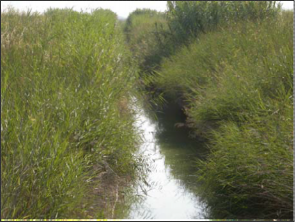
Overgrown ditches like this provide good shelter and nesting cover for hazardous birds
A named member of the senior management team at the airport should be responsible for the implementation of the bird control programme, including both habitat management and active bird control.
The reasons why birds frequent an airfield are not always obvious. They may be attracted to food such as invertebrates, small mammals, seeds or plants in the grassland; water from ponds, ditches, or puddles on the tarmac, nesting sites in trees, bushes or buildings, or simply the security offered by large open spaces where they can easily see approaching predators. In some cases it may be obvious what resources they are attracted to, but in others it may not. If there is any uncertainty, obtaining the assistance of a professional bird/wildlife prevention specialist isadvisable in order to identify what it is that is attracting the birds/wildlife to the airefield. Obviously, the attraction will vary from one species to another.
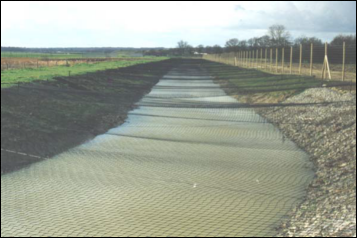
Cleared and netted drainage channels offer no bird attration whilst maximising their drainage functions
Once the attraction has been identified, a management plan should be developed either to remove it entirely, reduce it in quantity, or to deny access to it. Because airfields around the world are all different and because the bird/wildlife species that frequent them vary from region to region, it is not possible to define precisely what types of habitat management will be effective at a particular site.
Typical examples include manipulating the species and/or height of vegetation cover on theairport, removal of trees and bushes, netting of water bodies, excluding birds from buildings by netting or other means, selection of non-attractive amenity planting around terminals etc.. Whatever techniques are used, all airports should be able to show that they have assessed the bird attractions on their property and developed and implemented a habitat management plan to reduce these attractions as far as is practicable.
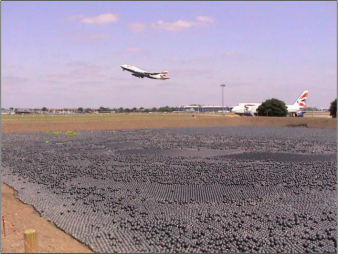
Water retention ponds can be proofed against Birds with netting or, as in this case with floating ‘bird balls’
An airport should undertake a review of the features on its property that attract hazardous birds/wildlife. The precise nature of the resource that the they are attracted to should be identified and a management plan developed to eliminate or reduce the quantity of that resource, or to deny birds access to it as far as is practicable.
Where necessary, support from a professional bird/wildlife strike prevention specialist should be sought.
Documentary evidence of this process, its implementation and outcomes should be kept.
-
Active Bird/Wildlife Control On The Airport
Effective bird/wildlife control requires that even small numbers of hazardous birds/wildlife are dispersed as soon as possible from the airfield. This avoids them becoming an attraction to other birds/wildlife as their presence indicates that there is food available on the airfield and/or that it is a safe place to rest. To achieve this, birds/wildlife need to be detected rapidly once they arrive and then dispersed quickly. Efficient detection cannot be achieved from the ATC tower or the Airfield Operations centre. Relying on Air Traffic Controllers to call out staff to disperse birds/wildlife will result in small numbers being missed. It will also result in a delayed response when birds/wildlife are detected, because it will take time for the controller to reach the particular location. Efficient detection requires the use of a mobile patrol, operated by trained and equipped staff who are able to disperse birds/wildlife immediately they are detected. If these staff are diverted to other duties, such as marshalling aircraft, the control will be reduced in efficiency. Bird/wildlife control at night is more problematic because it is often difficult to detect where birds that are dispersed from the airfield are moving to. Control of nocturnal mammals may only be possible at night when they are active.
A properly trained and equipped bird/wildlife controller should be present on the airfield for at least 15 minutes prior to any aircraft departure or arrival. Thus, if aircraft are landing or taking of at intervals of less than 15 minutes there should be a continuous presence on the airfield throughout daylight hours. The controller should not be required to undertake any duties other than bird control during this time. Note that for aerodromes with infrequent aircraft movements, 15 minutes may not be long enough to disperse all hazardous birds/wildlife from the vicinity of the runway. In this case the controller should be deployed sufficiently in advance of the aircraft movement to allow full dispersal to be achieved.
At night, active runways and taxiways should be checked for the presence of birds/wildlife at regular intervals and the dispersal action taken as needed.
-
Organisation
Different aerodromes adopt a variety of organisational structures for their bird/wildlife control programmes. These vary from having bird control as a secondary duty of the
Air Traffic Control or Fire Sections, through staffing bird control from the Airfield
Operations Section to employing specialist wildlife managers or bird control units. Bird control staffed from larger units has the advantage that there are more staff to call upon and greater flexibility to cope with sudden increases in bird numbers. However, staff employed primarily in other roles may regard bird control as a secondary or low status duty which, if they only carry it out on rare occasions, it not really their personal responsibility. Conversely, small specialist units are normally staffed by people who have a real interest in birds and bird control, and who clearly recognise that the responsibility for birds on the airfield lies with them. This ‘ownership’ of the bird problem can be a powerful motivation to improve standards of bird control. Such units may, however, find it difficult to cope with staff illness or sudden increases in bird numbers which require additional staff to be deployed.
Whichever organisational system is in place, it should deliver the standards described elsewhere in this document.
Collaboration and coordination between organisations on the airport
Communication between the various interested gropus and organisations on an airport is essential if good bird/wildlife control standards are to be achieved. Airfield Operations, Grounds Maintenance, Air Traffic Control, Airport Fire Service, Airport Planners, Airlines etc. All have a role to play in identifying and correcting problems that may occur. Airport management should ensure that a mechanism is available (e.g. an airport birdstrike prevention committee) which enables these organisations to participate in the bird/wildlife hazard management process. This will help to ensure that these organisations -
Equipment
The type and level of sophistication of the equipment needed to deter birds/wildlife from airfields depends on the species involved and the quantity of manpower that can be deployed. If a single staff member is required to disperse birds/wildlife from a large airport then equipment such as pistol launched pyrotechnics or distress call broadcasting devices will be essential. If more staff can be deployed or is the airport is small, then more basic equipment may suffice.
Bird/wildlife deterrent devices can be broadly divided into visual, acoustic and lethal, and subdivided into portable and static systems. The levels of sophistication, and hence cost, available are highly variable and include the simple scarecrow, (a static visual device), complex radio controlled sound grenerators (static acoustic), pyrotechnic pistols and vehicle mounted distress call apparatus (mobile acoustic), hand held lasers (mobile visual), traps (static lethal) and a shotgun (mobile lethal). The choice of which systems, or combination of systems, to deploy will depend on cost, legal and logistical constraints and, perhaps most importantly, on the species that need to be dispersed. For example, attempting to use a distress call system on a bird species which do not produce such calls is doomed to failure.
Relatively few of the bird/wildlife control devices available to airports have been subjected to a proper scientific evaluation of their effectiveness. It is not possible, therefore, to recommend particular devices as being suitable for bird control at every airport.

The limited use of lethal control is an important part of an effective bird management programme
Portable equipment, that requires a staff member on the airfield to operate it, is generally regarded as offering the best control, providing that the staff involved are properly trained and motivated. Devices such as pyrotechnic pistols, or vehicle mounted distress call generators produce an impression of a direct threat which can be continually varied in time and location by the operator in a manner not available to static systems. In all cases staff should have access to a shotgun to remove birds/wildlife that cannot be dispersed by non-lethal means, providing that the relevant bird protection and firearms legislation in the country concerned permits this. It is vital that staff are properly trained in the safe use of firearms and carry the necessary permits to own or operate the weapon. There is some debate as to the necessity of the use of lethal control in aerodrome bird/wildlife management, but the view of the vast majority of experts is that supporting the non-lethal threat of pyrotechnic and other devices with an element of lethal control is important because it helps to ensure that birds/wildlife do not habituate to the control programme and permits the selective removal of any birds/wildlife that fail to respond to the dispersal techniques deployed.
A mobile patrol equipped with scaring devices such as pyrotechnics and distress calls is the most efficient way to detect and disperse birds. -
In general, static bird scaring devices, such as gas cannons or other sound generators, gradually lose their effectiveness over time. Although some of the more sophisticated devices, which generate a variety of sounds in random or pre- programmed order, may delay this habituation, they are generally more suitable for providing short term bird deterrence from limited areas (e.g. ground being reinstated after building works).
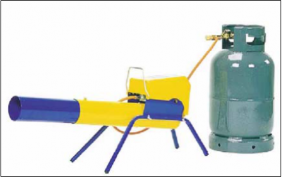
Gas Cannons, even if moved regularly, will eventually lose their effectiveness over time.
Trained predators (falcons and dogs) Trained falcons and dogs, which are both potential predators for many species of hazardous birds found on airports, are undobtedly effective in dispersing birds. To work properly, however, considerable investment in the training of both the animals and their handlers needs to be made. This training is essential both to ensure that the animals themselves do not become a strike risk and also to ensure that the deterrent value of deploying the falcon or dog is maximised. Airports should not underestimate the staff time and cost involved in incorporating falcons or dogs in their bird control programmes.
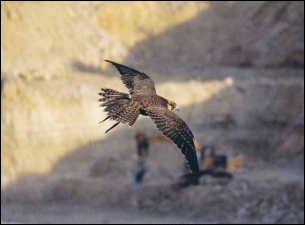
Falcons represent a real threat to birds and will not be ignored. Their use close to aircraft requires great care, skill and considerable expense.
It is also important to remember that falcons and dogs are not effective at dispersing all hazardous birds in all conditions. They should be regarded as one tool amongst many that the bird controller can use. The use of trained predators alone is not an adequate substitute for the other bird management techniques described above.
Bird control staff should be equipped with bird deterrent devices appropriate to the bird species encountered, the numbers of birds present, and to the area that they need to control. Staff should have access to appropriate devices for removal of birds/wildlife, such as firearms or traps, or the means of calling on expert support to supply these techniques at short notice.
All staff should receive proper training in the use of bird control devices.
-
Logging Bird/Wildlife Management Activities
There is an increasing tendency towards airlines and/or their insurers embarking on legal action to recover the costs of bird/wildlife strike damage from the airports at which they occur. It is important that airports record the bird control actions that they take in order to be able to show that they had an adequate bird/wildlife control programme in place at the time of an incident and that the programme was functioning properly. Data gathered as part of a bird/wildlife control programme is also important in assessing the effectiveness of the actions taken. A number of different methods for recording these data exist, from simple paper records to sophisticated devices based on pocket PC tecnnology. The latter save time and effort, especially if the data are to be subsequently entered onto a computer for further analysis. Whatever the means of recording used, the important issue is that a comprehensive record of the bird control activities is kept in order to demonstrate that the airport is following its own policies and procedures.
Airport bird/wildlife controllers should record the following at least every 30 minutes (if air traffic is sufficiently infrequent that bird patrols are more than 30 minutes apart, an entry should be made for each patrol carried out).
-
areas of the airport patrolled,
-
numbers, location and species of birds/wildlife seen,
-
action taken to disperse the birds/wildlife,
-
results of the action.
- More general information such as the name of the bird controller on duty, time on and off duty, weather conditions etc should be recorded at the start of a duty period.
-
-
Birdstrike Reporting
All bird/wildlife management programmes need to be monitored to see if they are working effectively and whether they need to be modified, extended or improved. The only effective way to do this is by collating data on the strikes at the airport concerned. Other measures, counting the birds/wildlife on the airfield for instance, provide useful additional information, but are not a direct measure of the strike risk at the airport. All strikes should be reported, whether or not they cause damage to the aircraft and whatever bird/wildlife species was involved. Unless the airport is confident that it knows what species are being struck on its property it cannot hope to target its management efforts in the correct direction. It is important that airport managers do not penalise staff for reporting birdstrikes. Even though strikes to large jet airliners from small species such as swallows or sparrow-sized birds are unlikely to cause damage to an aircraft, staff should be required to report them. Similarly, the total number of strikes at an airport should never be used as a measure of strike risk or of the performance of the bird/wildife controllers. The main risk arises from strikes with large species, especially birds that form flocks. A risk assessment process that combines strike frequency with likely severity needs to be employed to properly assess the risk (see below). Such a process cannot work effectively unless all strike are reported, however.
Definition of a bird/wildlife strike
There are a wide variety of definitions of precisely what constitutes a bird/wildlife strike. In terms of gathering information to better understand the risk, it is preferable to include as many events as possible in an inclusive definition. Including all strike reports in an airport’s dataset does raise a number of problems, however. For example, if a pilot reports a strike on approach to the airport and a check of the area for a carcass and inspection of the aircraft shows no evidence that a strike has taken place there is no confirmation that a strike has actually occured. Other than the location of the possible strike, such a report provides little useful information (e.g. bird species numbers damage levels etc.) that can aid the airport in targetting its bird control effort. These unconfirmed strikes should be recorded, but do not need to be subjected to the analysis described in 2.7 below.
A number of countries also record near misses in their bird/wildlife strike databases. The definition of a near miss is more problematic as it involves the pilot’s interpretation of how close the birds/wildlife was to the aeroplane and whether this constituted a threat to safety. Also, at airports situated in areas of high bird populations it might be difficult for an observant pilot to land or take off without seeing a bird at some distance from the aircraft and every movement might be regarded as a near miss. Accumulating near miss information may prove valuable, but, like unconfirmed strikes, they should not be included in the airport’s strike statistics used for analysis. Databases etc.should be set up to allow unconfirmed strikes and near misses to be separated from other bird/wildlife strikes when evaluating the dataset.
There are, however, some incidents where a strike does not occur, such as pilots being forced to take evasive action to avoid birds or wildlife, that should be recorded separately as these actions themselves are potentially dangerous and have been caused by the presence of birds.
Bird/wildlife incidents should therefore be defined in 3 categories:
Confirmed strikes:
Any reported collision between a bird or other wildlife and an aircraft for which evidence in the form of a carcass, remains or damage to the aircraft is found. Any bird/wildlife found dead on an airfield where there is no other obvious cause of death (e.g. struck by a car, flew into a window etc.).
Unconfirmed strikes:
Any reported collision between a bird or other wildlife and an aircraft for which no physical evidence is found.
Serious incidents:
Incidents where the presence of birds/wildlife on or around the airfield has any effect on a flight whether or not evidence of a strike can be found.
These definitions ensure that the maximum quantity of information is gathered, but that only reliable evidence is used in assessing the effectiveness of the bird/wildlife management programme. Depending upon the organisational structure in a particular country or at an individual airport, the responsibility for reporting bird/wildlife strikes may lie with a number of different individuals or departments, such as airport operations, air traffic control or pilots. It is important that the airport has a mechanism for ensuring that it is aware, as far as is possible, of all of the strikes that happen on or near its property.
-
Analysis of birdstrike data
Effective analysis of birdstrike data is particularly important. For example, separating strikes that occur on the airport (under 200 feet on approach and 500 feet on climb out using the ICAO definition) from those that occur further out in the approaches helps to define those strikes that are likely to be influenced by the airport bird management programme. Similarly, separating strikes with species that are over 100g in weight (i.e. those more likely to cause damage), and giving greater emphasis to strikes with flocks all help to identify trends in the real birdstrike risk at the airport. So, for example, an airport with an increasing rate of bird/wildlife strikes is not necessarily becoming a more risky place to fly. If the increase in strikes is due to an increase in incidents with small species, whilst the rate of strikes with large species and flocks is falling, then this is indicative of both better bird/wildlife control and better reporting of strikes. Again it is important to emphasise that the simple total number of strikes at an airport is not a good indicator of risk, and that examination of the data by species struck is essential. This process can be carried out as part of a formal risk assessment process as described in Section 11, page 17.
Bird/wildlife remains identification
Bird/wildlife strike statistics cannot be properly interpreted unless the species struck is known. The risk assessment process depends on a knowledge of the size of bird/wildlife struck to assess the likely severity of impacts, and the airport’s bird management programme may be targetting the wrong bird species if no record of what birds are being struck is kept. Bird/wildlife remains recovered following strikes are often fragmentary but even the smallest feather fragments can be identified and blood smears can be separated to species by the use of DNA analysis. Airports should ensure that all bird remains are identified as completely as possible given the facilities at their disposal.
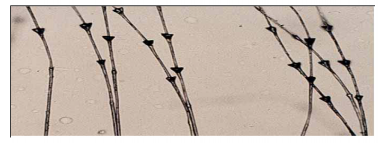

Even tiny feather fragments or bloodstains can be idenfified miscroscopically or by DNA analysis.
Data required in a birdstrike report
The more information that is recorded about a birdstrike incident the better. As a minimum, the data required on the ICAO birdstrike reporting form should be collected as fully as possible. If some data items are not available (e.g. altitude of strike) then as much information as possible should be collected and due account taken of the missing data during subsequent analyses.
Airports should establish a mechanism to ensure that they are informed of all bird/wildlife strikes reported on or near their property.
The total number of birdstrikes should never be used as a measure of risk or of the performance of the bird control measures at an airport.
Airports should ensure that the identification of the species involved in birdstrikes is as complete as possible.
Airports should record all birdstrikes and include, as far as they are able, the data required for the standard ICAO reporting form
National Regulators should collate birdstrike data and submit this to ICAO annually.
Submission to ICAO
Although this is not a matter directly for individual airports, countries should be encouraged to collate birdstrike data at the national level and to submit this to ICAO. This assists in assessing the true levels of birdstrike risk and costs to the aviation industry of birdstrikes around the world.
Risk Assessment
Formal risk assessment is now routinely used in almost all aspects of health and safety work. Bird/wildlife strike prevention has tended to lag behind in this field because the involvement of birds and other wildlife (creatures whose behaviour can vary hourly, daily and seasonally, and whose populations can fluctuate over longer periods) as a key component of the system being assessed makes it difficult to accurately predict risk levels. Techniques are now available that make use of the frequency that each species is struck, combined with probability of aircraft damage for that species, to calculate risk levels for a particular airport. These allow risk assessment matrices to be constructed and updated annually in order to evaluate how the risk level is changing in response to the bird management measures in place.
Airports should conduct a formal risk assessment of their birdstrike situation and use the results to help target their bird management measures and to monitor their effectiveness. Risk assessments should be updated at regular intervals, preferably annually.
Bird/wildlife management off the airfield
Providing that best practice in terms of habitat management and active control are put in place on an airfield, the strike risk arising from the airfield itself can be largely controlled in all but the most extreme circumstances. Managing the strike risk that originates from off the airfield is a more complex and difficult challenge. Firstly, the problematic sites need to be identified by means of a hazard assessment. This can pose problems because, for some species, such as gulls, the sites frome which birds that cause a risk at the airport originate can be many miles from the airport itself. Having identified sites that support hazardous birds/wildlife it is then necessary to estimate the risk that they pose to the airport. Birds/wildlife on the airport itself can reasonably be assumed to pose some level of risk as their proximity to the aircraft means that they will eventually cross a runway ot taxiway and may thus be struck. Birds/wildlife at a site remote from the airport may pose no risk at all if they never cross the airfield or its approaches. The same basic principles apply when developing a management plan whether it is on or off the airfield. A risk assessment thus requires either a measurement or an estimation of how often birds/wildlife at an off airfield site will transit the active airspace. Once sites that pose a significant risk are identified, the management principles that are needed to control the risk are similar to those on airfield. They are to identify the attractions, then to manage the habitat to reduce the attraction, or deny the birds access to it. Dispersal tactics can then be deployed to remove any birds that remain. This will require a collaborative approach and positive working relationship with local landowners.
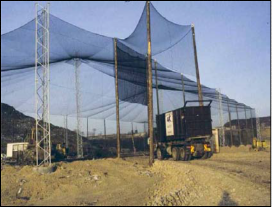
Landfills close to airports can be netted to exclude hazardous birds
Part of the new ICAO standards concerning airport bird control states that:
The appropriate authority shall take action to eliminate or to prevent the establishment of garbage disposal dumps or any such other source attracting bird activity on, or in the vicinity of, an aerodrome unless an appropriate aeronautical study indicates that they are unlikely to create conditions conducive to a bird hazard problem.
Whilst the reference to garbage dumps is clear, ‘any such other source attracting bird activity’ requires a significant degree of interpretation. As with the bird/wildlife attractions on the aerodrome, airport managers may need to seek assistance form specialists when identifying the major bird/wildlife attractions near their airport. They will certainly require some assistance in assessing whether the birds/wildlife using such a site pose a significant risk to flight safety, as this needs an understanding of ecology and behaviour that is unlikely to be available from within the airport’s own staff.
Once sites that support birds/wildlife that are, or might, cause a flight safety problem are identified, management options can be developed. These can range from minor habitat modification, changing cropping or other agricultural practices, major drainage operations or large scale removal of bird/wildlife populations. Again the choice of technique will depend on the particular situation encountered and expert advice should be sought if necessary. Larger scale off-airport bird/wildlife management may also involve liaison with local conservation interests, especially if the sites that need to be managed are nature reserves. In some cases it may be impossible to resolve the conflicting interests of flight safety and conservation, but in trying to do so the airport will be in a better position to show due diligence in the event of an accident or legal claim in the future.
Airports should conduct an inventory of bird attracting sites within the ICAO defined 13km bird circle, paying particular attention to sites close to the airfield and the approach and departure corridors. A basic risk assessment should be carried out to determine whether the movement patterns of birds/wildlife attracted to these sites means that they cause, or may cause, a risk to air traffic. If this is the case, options for bird management at the site(s) concerned should be developed and a more detailed risk assessment performed to determine if it is possible and/or cost effective to implement management processes at the site(s) concerned. This process should be repeated annually to identify new sites or changes in the risk levels produced by existing sites.
Where national laws permit, airports, or airport authorities, should seek to have an input into planning decisions and land use practices within the 13km bird circle for any development that may attract significant numbers of hazardous birds/wildlife. Such developments should be subjected to a similar risk assessment process as described above and changes sought, or the proposal opposed, if a significant increase in birdstrike risk is likely to result.
ACI (2005). Aerodrome Bird Hazard Prevention and Wildlife Management Handbook
First Edition. Airports Council International, Geneva.
CAA. (1998). CAP 680 Bird Control On Aerodromes. Civil Aviation Authority, London.
Cleary, E.C. & Dolbeer, R.A. (1999) Wildlife hazard management at airports, a manual for airport personnel. US Federal Aviation Administration, Washington DC.
Transport Canada (2001).Sharing The Skys – An Aviation Guide To The Management Of Wildlife Hazards. Transport Canada, Ottawa.
